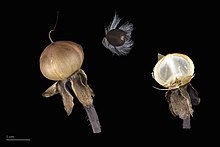This article needs more reliable medical references for verification or relies too heavily on primary sources. (November 2014) |  |
| Ipomoea | |
|---|---|

| |
| Ipomoea pes-tigridis, the type species of the genus | |
| Scientific classification | |
| Kingdom: | Plantae |
| Clade: | Tracheophytes |
| Clade: | Angiosperms |
| Clade: | Eudicots |
| Clade: | Asterids |
| Order: | Solanales |
| Family: | Convolvulaceae |
| Tribe: | Ipomoeeae |
| Genus: | Ipomoea L. 1753[1] |
| Species | |
|
More than 600, see list | |
| Synonyms[2] | |
|
List
| |





Ipomoea (/ˌɪpəˈmiː.ə, -oʊ-/)[3][4] is the largest genus in the plant family Convolvulaceae, with over 600 species. It is a large and diverse group, with common names including morning glory, water convolvulus or water spinach, sweet potato, bindweed, moonflower, etc.[5] The genus occurs throughout the tropical and subtropical regions of the world, and comprises annual and perennial herbaceous plants, lianas, shrubs, and small trees; most of the species are twining climbing plants.
Their most widespread common name is morning glory, but some species in related genera bear that same common name and some Ipomoea species are known by different common names. Those formerly separated in Calonyction[6] (Greek καλός kalós "good" and νύξ, νυκτός núx, nuktós, "night") are called moonflowers.[5] The name Ipomoea is derived from the Ancient Greek ἴψ, meaning 'woodworm', and ὅμοιος (hómoios), meaning "resembling". It refers to their twining habit.[7]
- ^ "Genus: Ipomoea L." Germplasm Resources Information Network. United States Department of Agriculture. 2007-10-05. Archived from the original on 2010-05-28. Retrieved 2010-11-10.
- ^ "Ipomoea L." Plants of the World Online. Board of Trustees of the Royal Botanic Gardens, Kew. 2017. Retrieved 15 July 2020.
- ^ "Ipomoea". Lexico UK English Dictionary. Oxford University Press. Archived from the original on 2020-03-22.
- ^ Sunset Western Garden Book. 1995. pp. 606–07.
- ^ a b Gunn, Charles R. (1972). "moonflower". Brittonia. 24 (2): 150–168. doi:10.2307/2805866. JSTOR 2805866. S2CID 44714712.
- ^ Gunn, Charles R. (1972). "Calonyction". Brittonia. 24 (2): 150–168. doi:10.2307/2805866. JSTOR 2805866. S2CID 44714712.
- ^ Austin, Daniel F. (2004). Florida Ethnobotany. CRC Press. p. 365. ISBN 978-0-8493-2332-4.